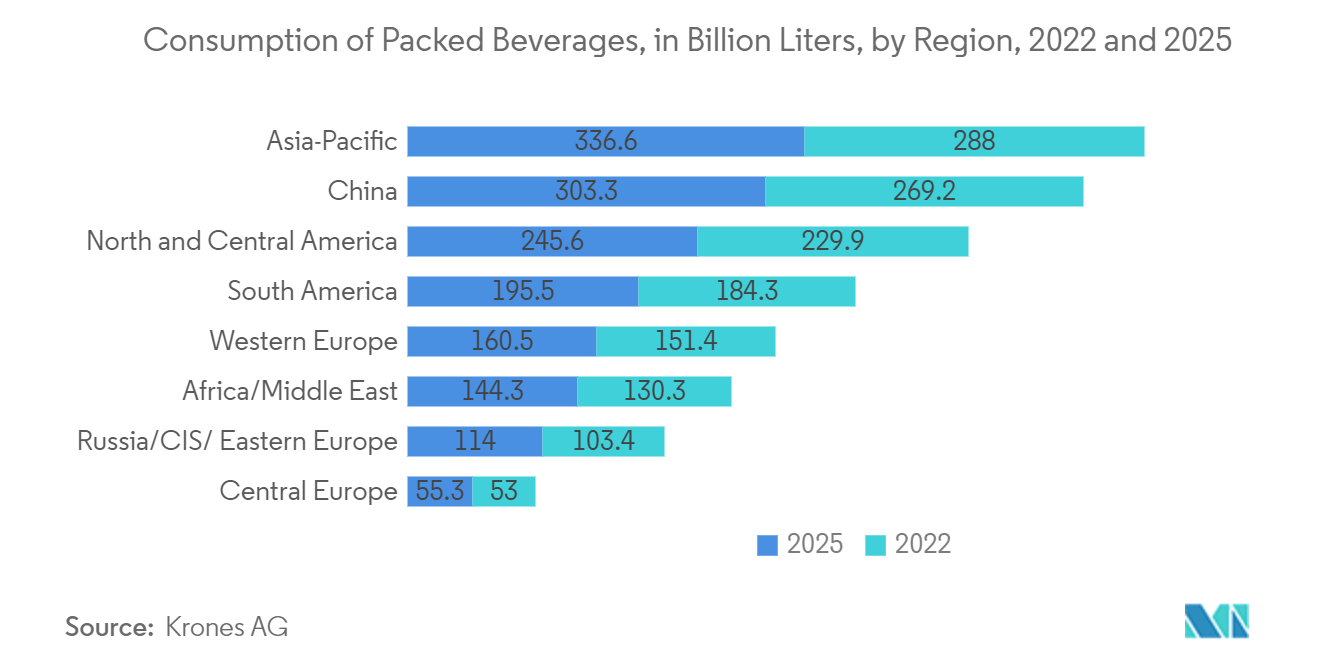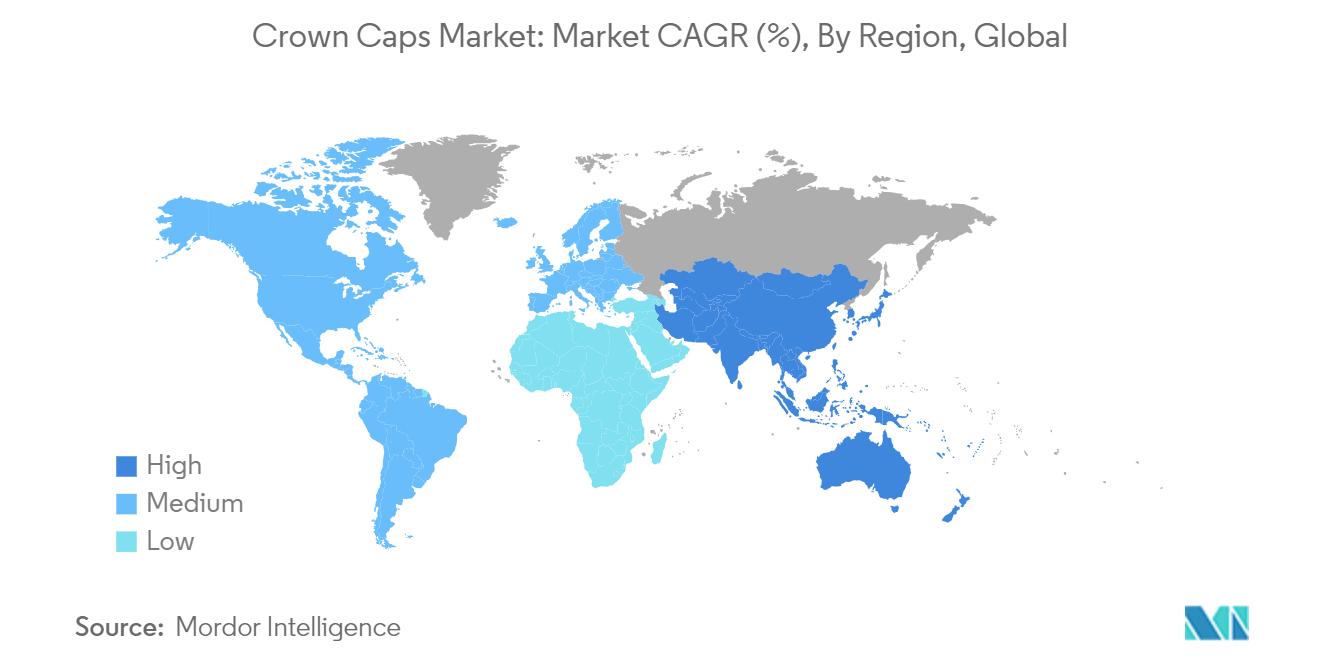Market Trends of Crown Caps Industry
Non-Alcoholic Beverages are Expected to Hold a Significant Share
- Carbonated drinks taste best when stored in glass bottles. The thick layer of the glass bottle does not allow the carbon dioxide present in the drink to escape through it. This makes the drink look fizzy. When stored in a plastic bottle, the CO2 content easily leaks out of the plastic compared to a glass jar. Owing to their recyclability, metal crown caps are mainly used with glass bottles. Therefore, soft drinks hold a significant share of the market studied, owing to their popularity worldwide.
- Soft drinks hold a prominent share of single-use plastic bottles globally. Nevertheless, various soft drink vendors are currently switching back to glass bottles owing to the increasing government regulation and reduced packaging cost, requiring the crown caps market to grow on a similar trend. For instance, after focusing on disposable plastic bottles for many years, from February 2022, beverage manufacturer Coca-Cola India Pvt. Ltd now and again marketed returnable glass bottles in India. This modification lowers the cost of packaging while expanding the company's user base and pushing the demand for metal cans across the Indian market.
- Furthermore, in October 2023, Coca-Cola Hellenic Bottling Company (HBC) unveiled that it invested EUR 12 million (USD 12.7 million) in a new high-speed returnable glass bottle manufacturing equipment at its Austrian facility. For the Austrian market, the new glass bottles line is anticipated to produce 400 ml returnable glass bottles that can be resealable. By increasing the use of reusable packaging, container collection is integrated into the beverage delivery model, and there would be a rising demand for crowns for reusable bottles.
- As per the 2022 annual report published by Krones AG, a German packaging and bottling machine producer, global consumption of packaged beverages amounted to nearly 1.4 trillion liters in 2022. Also, Asia-Pacific had the highest consumption of packaged beverages, which was 288 billion liters in 2022. It is expected to be escalated to reach 336.6 billion liters in 2025. According to the forecasts, all the major regions across the globe are expected to witness growth in the consumption of packaged beverages, which, in turn, is anticipated to contribute to the growth of the crown caps market.
- Notably, several soft drink manufacturers are constantly making mergers, acquisitions, and partnerships for the launch of sustainable and recyclable glass bottles that come with crown caps. In December 2022, a new refillable, one-serve, custom-made glass bottle was launched by the Malta-based Pepsico partner, Simonds Farsons, for flagship brands, including Pepsi-Cola, Pepsi Max, 7up, 7up Free, and Mirinda.

Asia-Pacific to Witness Fastest Growth
- Factors like rapid urbanization, growing middle-class income, and higher consumer purchasing power contribute to the rise in alcoholic and non-alcoholic beverage demand. In addition, the number of people who drink alcohol and the desire to socialize through partying and social gatherings have increased dramatically. Changing social and cultural factors have also strengthened the potential of the alcoholic beverage market in the Asia-Pacific region, which may propel the growth of crown caps and closures during the forecast period.
- Asia-Pacific is expected to witness the fastest growth because of the presence of two highly populated countries, i.e., China and India. In these two countries, the increase in disposable income is expected to supplement the growth of the crown caps market. Owing to the increasing demand in the region, companies operating in the region have grown to cater to the demand of other countries as well. Notably, as per the report published in January 2023 by the National Bureau of Statistics of China, the country exported 479.44 million liters of beer globally in 2022, significantly up from 424.20 million liters in 2021.
- A considerable increase in beer consumption has been observed in India due to its growing youth population that prefers beer. Changing lifestyles and consumer preferences have considerably boosted the adoption of beer in the Asia-Pacific region. Moreover, according to Agriculture and Agri-Food Canada, beer volume consumption in India is expected to increase from 2.23 billion liters in 2021 to 2.6 billion liters in 2025. This increase is expected to bolster the market growth in India during the forecast period.
- There has been consistent growth in preference for beverages with low levels of alcohol, and the sales of no-alcohol and low-alcohol beers have been rising with the growing interest from health-conscious consumers and a wider choice of new ranges with improved taste. Another driving factor is that beers with low levels of alcohol, those with 2.8% alcohol by volume (ABV) and less, are now cheaper than their high-alcohol equivalents.
- Moreover, the growing production of non-alcoholic beverages in China is expected to support market growth during the projected timeframe. For instance, according to the National Bureau of Statistics of China, the country produced over 18.91 million metric tons of non-alcoholic beverages in July 2023, which represented the highest production in the few months after January 2023. This upswing is expected to continue in the forecast period, and it is anticipated to increase the demand for crown caps in the region.


